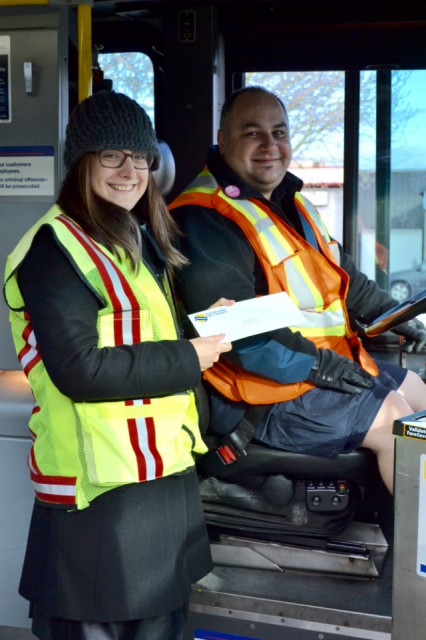From planning department to transit centre: A three-month experience
From planning department to transit centre: A three-month experience

Meet Michelle Babiuk. She’s the one in the hat, above. Hi Michelle! She is a TransLink transportation planner in Infrastructure and Network Management. But for the past few months, she’s taken on a different, temporary role. That of operations supervisor out of the Burnaby Transit Centre.
While working closely with the depot manager in her planning position, it was suggested that it might be a good experience for her to get out there and see what drivers and supervisors experience every day. So she did! It’s three months later and she’s learned a lot that she will be taking back to the planning department at TransLink. We sat down with Michelle to talk about her experience.
Why did you take a secondment to become an operations supervisor?
My thought was, the more I see on the ground, the better I can plan. On the infrastructure and network design side, you can understand how operators are using the system and what their experiences are. The more you understand what people do out there the more you understand what you’re seeing in the data. This allows you to better plan or design something that is realistic. Drivers have a lot of information we don’t and that’s very valuable.I also wanted to learn the rhythm of a day at a transit centre. What do the supervisors do? What do the operators do? What are the potential communication touch points and tools that we can use to reach people? We want to get information back from them because they have suggestions just like the public does. We also want to find the best way we can get information out to them.
What have you learned while in the supervisor role?
The most interesting thing I’ve learned is what it is like to work with a mobile workforce. I have a large number of operators that work all different shifts and some you see very rarely. That’s why it’s important to get out there on the routes and interact with them to give and receive information.
Day to day, that was one of the challenges. I think the staff here work really hard to be out meeting people on their buses in the evenings, on weekends and if they can find a spare minute, during the day. The operators really appreciate it. When you deliver awards on the bus, people get really excited! They feel like you’re seeing their reality by being on the bus with them.
What will you take from this experience back to your planner role?
The easiest thing to action from what I’ve learned from my time here is communications. Understanding what opportunities there are here to increase communication and how information spreads. We can be out there and be visible with information sessions – like the ones CMBC planning and scheduling do now four times a year.
I’ve seen other ways information gets shared, like a paddle stuffer. So anyone starting their shift picks up their paddle [wooden boards with daily route info and more] and gets anything you need to tell them. You can’t relay a ton of information that way, but you can let the operators know what’s going on with certain projects and how they can give feedback.
We’ve also been exploring the idea of getting out in the evenings and doing some work at bus loops. Operators can spread the word from those interactions, too. It’s about learning what works for all sides, how to ask questions and provide information that resonates with operators.
Getting out of the office to visit Michelle at a transit centre was a great experience for me, too!
It was such a pleasure to meet George, hear his stories from the front lines and see what happens before the buses get out on the road. Understanding how he and other operators interact with our riders is so valuable. The more opportunities we have to hear what operators and riders are saying, the better we can work together to make positive changes across the system.
Thanks so much for the interview, Michelle and good luck heading back to the planning team!
Author: Adrienne Coling





